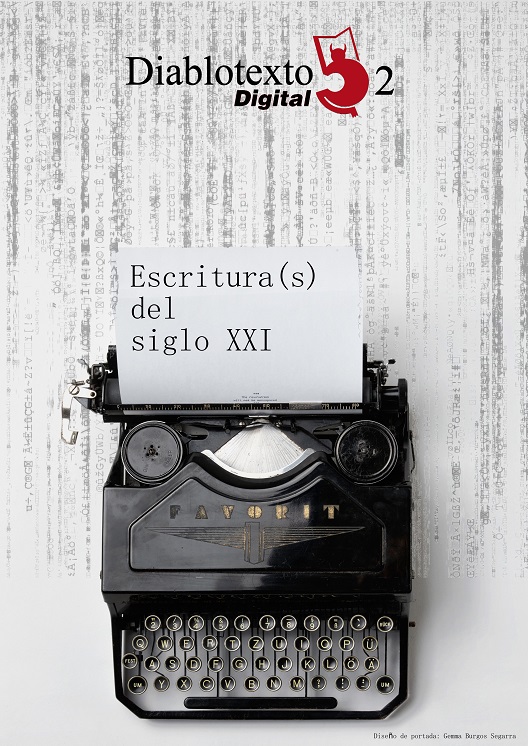The autofictional provocation of Great Vilas
DOI:
https://doi.org/10.7203/diablotexto.2.9838Keywords:
autofiction, poetry, Manuel Vilas, parody, Great Vilas Abstract
Abstract
The poetics that exploit homonymy shake conventional lyrical gender profiles, historically tied to non-fictional discourse, and experience a proliferation of alternative labels like "autofiction". One of the most recent book of poetry that best illustrates this ludic game of autofiction is Great Vilas (2012) of the prolific writer Manuel Vilas (Huesca, 1962). Humor and love share letters and syllables (in spanish) in his aesthetic proposal. And the game of the author’s name do not seek to consolidate a perfect ego, but shows his social nature, its provocative otherness, its healthy inconsistency.
 Downloads
Downloads
 References
References
BAGUÉ QUÍLEZ, LUIS (2013). “La vida exagerada de Manuel Vilas”, Turia: Revista Cultural, 105-106, pp.483-485.
COLONNA, VINCENT (2004). Autofiction & autres mythomanies littéraires. Auch: Tristram.
CONSUEGRA, CRISTINA (2012). “Entrevista a Manuel Vilas: «Gran Vilas es un título erótico»”, Culturama, en http://www.culturamas.es/blog/2012/08/19/gran-vilas-es-un-titulo-erotico/ [Fecha de consulta: 24 de junio de 2016].
DELEUZE, GILLES Y FÉLIX GUATTARI (1978). Kafka. Por una literatura menor. México: Era.
DOUBROSVKY, SERGE (1977). Fils. París: Galilée.
FOUCAULT, MICHEL (1989). "¿Qué es un autor?", Revista Conjetural, n.º 1, pp. 87-111.
GENETTE, GERARD (2004). Metalepsis. De la figura a la ficción. Buenos Aires: FCE.
GÓMEZ, SONIA (2015). “Juegos autoficcionales en la obra de Manuel Vilas”, Pasavento. Revista de Estudios Hispánicos, vol. III, n.º 1, pp.155-169.
GUTIÉRREZ VALENCIA, CRISTINA (2015). “A Jocis Ad Seria: La risa ambivalente en la obra humorística de Manuel Vilas”, Pasavento. Revista de Estudios Hispánicos, vol. III, n.º 2, pp.121-145.
LEJEUNE, PHILIPPE (1994). El pacto autobiográfico y otros estudios. Madrid: Megazul-Endymion.
LEJEUNE, PHILIPPE (2001). “Definir la autobiografía”, Boletín de la Unidad de Estudios Biográficos, Universitat de Barcelona, n.º 5, pp. 9-18.
SCARANO, LAURA (2011a). “Metapoeta: el autor en el poema”, Boletín Hispánico Helvético. Historia, teoría(s), prácticas culturales, n.º 17-18, pp.321-346.
SCARANO, LAURA (2011b). “Poesía y nombre de autor: Entre el imaginario autobiográfico y la autoficción”, Revista Celehis, n.º 22, pp.219-240.
SCARANO, LAURA (2013). “Metapoetas de carne y verso”. En Laura Scarano (ed.), La poesía en su laberinto. AutoRepresentacioneS I. Binges, Francia: Editions Orbis Tertius.
SCARANO, LAURA (2014). Vidas en verso. Autoficciones poéticas (estudio y Antología). Santa Fe: Editorial de la Universidad del Litoral.
VILAS, MANUEL (2009). “Entrevista a Manuel Vilas realizada durante la Feria del Libro de Gotemburgo”, Instituto Cervantes Estocolmo, en https://www.youtube.com/watch?v=gch-7oFf2h8 [Fecha de consulta: 22 de junio de 2016].
VILAS, MANUEL (2010). Amor. Poesía reunida. 1988-2010. Madrid: Visor.
VILAS, MANUEL (2012). Gran Vilas. Madrid: Visor.
VILAS, MANUEL (2014). “Entrevista a Manuel Vilas”, realizada por Pablo Rodríguez Balbontín y Marion Betriu, Iowa Literaria, en https://www.youtube.com/watch?v=MlvoN90XcRQ [Fecha de consulta: 27 de junio de 2016].
VILAS, MANUEL (2016). Poesía Completa (1980-2015). Madrid: Visor.
VILAS, MANUEL (2017). América. Barcelona: Círculo de Tiza.
Downloads
Published
How to Cite
-
Abstract800
-
PDF (Español)460
Issue
Section
License
Licencia de reconocimiento de Creative Commons “Reconocimiento - No Comercia l- Sin Obra Derivada
Authors who publish with this journal agree to the following items:
The authors will keep their copyright and guarantee the journal the right of first publication of their work, which will be simultaneously subject to the Creative Commons license that allows third parties to share the work indicating its author and its first publication in the journal. The authors may adopt other non-exclusive license agreements to distribute the version of the published work (e.g., depositing it in an institutional telematic file or publishing it in a monographic volume), with an acknowledgment of its initial publication in this journal. The authors are allowed and encouraged to disseminate their work through the Internet (e.g., in institutional telematic archives or on their website) before and during the submission process, which can produce interesting exchanges and increase citations of the published work. (See Effect of Open Access)




